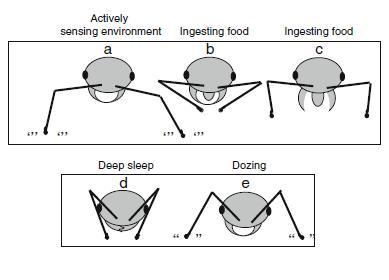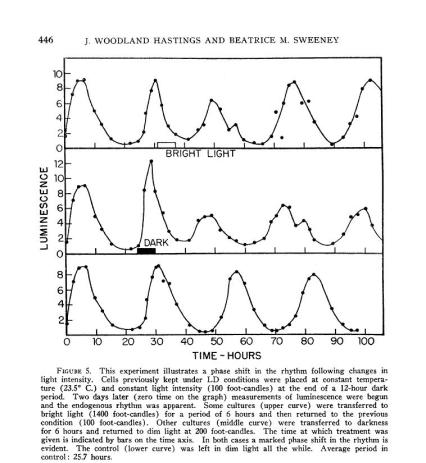In circadian research, it is common to sleep deprive animals by means of gentle handling. Yesterday, however, the lab techinician and myself learned an invaluable lesson; mice become chronically stressed from gentle handling, and such stress may lead to cardiac arrest. This event ensued as we attempted to perform a manual microdialysis collection. For those not familiar with this procedure, an inflow line of artifical cerebral spinal fluid, which circulates in ventricles throughout the brain, is pumped through a probe (see blue cap), and is utilized to measure the extracellular environment of a particular region of study. In this case, I am interested in measuring the time course of ethanol metabolism in the suprachiasmic nucleus following an acute injection of ethanol (see previous SCN blog for more details of its function [hey! you should know this by now!]). This photo is courtesy of http://www.montegraphia.com.
Archive for April, 2009
Warning: Gentle Handling May Cause Death
April 30, 2009
Even Genes Have To Work…
April 29, 2009
Researchers at the University of Pennsylvania recently discovered ultradian genes that are critical components of the circadian clock. To clarify, ultradian gene expression waxes and wanes several times across a 24 hour period. Below are wonderfully aesthetic “geneograms” depicting oscillations of these genes. With pertinence to the “human condition,” genetic expression that oscillates across an 8 hour period may assist in the development of genetic therapies that mitigate work-related stress in individuals with or predisposed to anxiety disorders.
Spiders Love Mary Janes
April 27, 2009
In 1960, Dr. Peter Witt gave spiders various drugs such as alcohol, marijuana, and hallucinogens in order to study how these pharmacological agents affected web building. It would have been an enjoyable study to replicate in Costa Rica since spiders inhabitated the Alberto Manuel Brenes Biological Reserve in great numbers.
Sleep Architecture in a Fire Ant (and other ant trivia)
April 26, 2009
In Costa Rica, I saw numerous leaf cutter and army ants. Though I was antcipating seeing a bullet ant, I did not. During such citings, I learned from http://www.montegraphia. com that leaf cutter ants can carry detritus that amasses to 6-20 TIMES body weight. Upon leaving Costa Rica, I read an article on Sleep Architecture in the Fire Ant sent by a fellow graduate student. Once again, I was mesmerized by ant trivia as I learned there are disparities in sleep between workers and queens; Workers have short and frequent episodes of sleep, while queens have extended episodes of sleep. Extended sleep in queens is hypothesized to improve reproductive fitness. Increased reproductive fitness of queens also manifests from synchonizing sleep architecture across a sleep episode by means of “cuddling” with each other. Even more interesting, ants exhibit RAM sleep or RAPID ANTENNA MOVEMENT which is comparable to the rapid eye movements seen during REM sleep in mammals. As illustrated below, ants also exemplify species-specific sleeping postures that are stereotypic for different sleep architecture.
Saturday Night Trivia: Sleep Edition
April 26, 2009
In a recent post by the National Sleep Foundation, five trivial, yet interesting facts about sleeping habits in humans and other organisms were published. Study hard, because they might appear on Final Jeopardy someday…
- If it takes you less than five minutes to fall asleep at night, you’re sleep-deprived. The ideal is 10 to 15 minutes, which means you’re tired enough to sleep deeply, but not so exhausted you feel sleepy during the day; This is an objective measure of sleepiness and a preliminary test for sleep apnea or insomnia in which the individual takes less than 5 min or greater than 30 min, respectively, to fall asleep under “normal” circumstances.
- A new baby typically results in 400-750 hours of lost sleep for parents in the first year; this is ironic considering that babies sleep an average of 16 HOURS a day.
- Elephants sleep standing up during non-REM sleep, but lie down for REM sleep; I suppose this disparity arises from REM-induced muscle atonia, which everyone should know from a previous blog entry (hint hint; read my blog…).
- After five nights of partial sleep deprivation, three drinks will have the same effect on your body as six would when you’ve slept enough; Alcohol = Hypnotic + Sleep Deprivation = Hypnotic ==RED ALERT (a modification of Dr. William C. Dement’s infamous quote, “Drowsiness is red alert.”
- Humans sleep on average of about three hours less than other primates such as chimps, rhesus monkeys, squirrel monkeys and baboons, all of which sleep for 10 hours; Got electricity?.
Sleep Tight OR Let the Bed Bugs Bite
April 23, 2009
Within the past week, news of an accelerated bed bug outbreak has been a recurring story in the New York Times and Associated Press. This information is serendipitous for me because I encountered bed bugs for the first time in Costa Rica. Below is a schematic illustrating the life cycle of a bed bug; en route to facilitating a sleepless night.
Science Daily Celebrates 4/20
April 21, 2009
Yesterday, a study reported in Science Daily discovered receptors within the brain that are remarkably similar in structure and function to THC receptors; the receptors to which marijuana binds to modulate pain, eating, and cognitive functioning. Not only are these receptors critical for sound neuronal functioning, but activation of these receptors may benefit individuals with chronic pain, drug dependence, or metabolic disorders. For more studies pertinent to marijuana use, its effects on neuronal functioning, and implications for public health see the article. In the meantime, entrust Bob Dylan’s advice–“everybody must get stoned”– wait, our brains already are.
How Do YOU Sleep?
April 21, 2009
While listening to the Cake channel on http://www.pandora.com today, I quickly attended to the song “When You Sleep,” in which Cake yeans to know “where do [your] fingers go?” while sleeping. I will now attempt to answer this riddle. First off, I must determine if the individual is truly asleep by observing each of the four criteria used to identify behavioral sleep. The organism in question must exhibit all four criteria in order to characterize the episode as true somnolence or relaxed wakefulness. These criteria include:
1. An absence of locomotor activity; true for healthy individuals, but certainly not for those with REM behavior disorder (see blog entry “The Facts About Pathological Sleep And Dreaming Per The Penguin Dictionary” for more information).
2. Stereotypic and species specific posture; while posture during sleep can be comparable across species, the posture must, nonetheless, be discernible from those maintained during waking.
3. Rapid state of reversibility; does anyone have a foghorn?!
4. Increased sensory thresholds with continual sleep; this criterium is most difficult to measure because it may require the usage of polysomnography to determine the stage of sleep. But, blasting “Smells Like Teen Spirit” by Nirvana may suffice.
Moreover, if the individual is asleep, then “where fingers go” during sleep must be similar across organisms within a species, and in the case of humans, must be independent of race, socioeconmic status, ethnicity, and other demographic data. However, stereotypic and species specific corporeal postures during sleep are not evident in this artistic rendition of “When You Sleep;” it seems to appraise the uniqueness and even the eccentricity of human sleep.
Hey, I don’t even know where my fingers go when I sleep. Do you?
No Red Light Districts in the Pacific, Thank Goodness
April 19, 2009
While residing at the Campanario Biological Reserve, the creator of www.montegraphia.com, myself, and our friends decided to go for a twilight dip in the Pacific. As we approached the crashing waves, I immediately realized why I had never appreciated the sidereal beauty of the night in suburbia; damn you, light pollution. After haphazardly walking through the crashing waves, we were confronted with another beauty of Mother Nature: bioluminscent dinoflagellates! These dinoflagellates, perhaps Gonyaulax polyedra, were much more tolerable than Lingulodium polyedra, which are responsible for red tides, and squander a surfer’s happiness (I hate you Lingulodium polyedra).
Ironically enough, that same day, I had read an excerpt from The Handbook of Neurobiology: Biological Rhythms describing the circadian rhythm of mitosis, photosynthesis, luminescence, and glow in Gonyaulax polyedra . Below is a picture from the study published by Mitch Hastings, the current recipient of Ashoff’s Ruler given by the Society of Research on Biological Rhythms.
From: A persistent diurnal rhythm of luminescence in Gonyaulax Polyedra (Biol Bull 115: 440-458; 1958);
Extreme Latitudes and Apotosis
April 17, 2009


 In addition to the frigid temperatures of extremes latitudes, it has recently been evidenced that long-term exposure to darkness, such as that experienced during a winter solstice, faciliates neurodegeneration. Below is an image illustrating accelerated apotosis in a dopaminergic neuron within the central drug reward circuit. Serotonergic and acetylcholinergic neurons are also damaged from long-term exposure to darkness, which in turn, may disrupt the consolidation of sleep and wake, increase the risk of developing depression, and catalyze alcohol abuse and dependence.
In addition to the frigid temperatures of extremes latitudes, it has recently been evidenced that long-term exposure to darkness, such as that experienced during a winter solstice, faciliates neurodegeneration. Below is an image illustrating accelerated apotosis in a dopaminergic neuron within the central drug reward circuit. Serotonergic and acetylcholinergic neurons are also damaged from long-term exposure to darkness, which in turn, may disrupt the consolidation of sleep and wake, increase the risk of developing depression, and catalyze alcohol abuse and dependence.
Apotosis of Aminergic Neurons Following Long-Term Exposure to Constant Darkness





